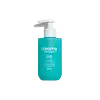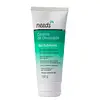What's inside
What's inside
 Key Ingredients
Key Ingredients

 Benefits
Benefits

 Concerns
Concerns

 Ingredients Side-by-side
Ingredients Side-by-side

Water
Skin ConditioningSodium Cocoyl Alaninate
Glycerin
HumectantPEG-150 Distearate
EmulsifyingCocamidopropyl Betaine
CleansingSodium PCA
HumectantSodium Chloride
MaskingDecyl Glucoside
CleansingCocamide Mipa
EmulsifyingPhenoxyethanol
PreservativePolysorbate 20
EmulsifyingPotassium Laureth-4 Carboxylate
Centella Asiatica Extract
CleansingHydroxypropyl Guar Hydroxypropyltrimonium Chloride
Propylene Glycol
HumectantChamomilla Recutita Flower Extract
MaskingPolyacrylate Crosspolymer-6
Emulsion StabilisingZinc PCA
HumectantSodium Gluconate
Skin ConditioningSodium Citrate
BufferingEthylhexylglycerin
Skin ConditioningPEG-120 Methyl Glucose Trioleate
CleansingT-Butyl Alcohol
PerfumingWater, Sodium Cocoyl Alaninate, Glycerin, PEG-150 Distearate, Cocamidopropyl Betaine, Sodium PCA, Sodium Chloride, Decyl Glucoside, Cocamide Mipa, Phenoxyethanol, Polysorbate 20, Potassium Laureth-4 Carboxylate, Centella Asiatica Extract, Hydroxypropyl Guar Hydroxypropyltrimonium Chloride, Propylene Glycol, Chamomilla Recutita Flower Extract, Polyacrylate Crosspolymer-6, Zinc PCA, Sodium Gluconate, Sodium Citrate, Ethylhexylglycerin, PEG-120 Methyl Glucose Trioleate, T-Butyl Alcohol
Water
Skin ConditioningSodium Laureth Sulfate
CleansingDisodium Laureth Sulfosuccinate
CleansingCocamide DEA
EmulsifyingSodium Hydroxide
BufferingPropylene Glycol
HumectantPEG-120 Methyl Glucose Dioleate
EmulsifyingPropanediol
SolventGlycolic Acid
BufferingPhenoxyethanol
PreservativeEthylhexylglycerin
Skin ConditioningSalicylic Acid
MaskingAcrylates/C10-30 Alkyl Acrylate Crosspolymer
Emulsion StabilisingParfum
MaskingCucumis Sativus Fruit Extract
EmollientGlycerin
HumectantPanthenol
Skin ConditioningCI 42090
Cosmetic ColorantBenzotriazolyl Dodecyl P-Cresol
UV AbsorberAllantoin
Skin ConditioningDisodium EDTA
CI 19140
Cosmetic ColorantHexyl Cinnamal
PerfumingLinalool
PerfumingWater, Sodium Laureth Sulfate, Disodium Laureth Sulfosuccinate, Cocamide DEA, Sodium Hydroxide, Propylene Glycol, PEG-120 Methyl Glucose Dioleate, Propanediol, Glycolic Acid, Phenoxyethanol, Ethylhexylglycerin, Salicylic Acid, Acrylates/C10-30 Alkyl Acrylate Crosspolymer, Parfum, Cucumis Sativus Fruit Extract, Glycerin, Panthenol, CI 42090, Benzotriazolyl Dodecyl P-Cresol, Allantoin, Disodium EDTA, CI 19140, Hexyl Cinnamal, Linalool
Ingredients Explained
These ingredients are found in both products.
Ingredients higher up in an ingredient list are typically present in a larger amount.
Ethylhexylglycerin (we can't pronounce this either) is commonly used as a preservative and skin softener. It is derived from glyceryl.
You might see Ethylhexylglycerin often paired with other preservatives such as phenoxyethanol. Ethylhexylglycerin has been found to increase the effectiveness of these other preservatives.
Glycerin is already naturally found in your skin. It helps moisturize and protect your skin.
A study from 2016 found glycerin to be more effective as a humectant than AHAs and hyaluronic acid.
As a humectant, it helps the skin stay hydrated by pulling moisture to your skin. The low molecular weight of glycerin allows it to pull moisture into the deeper layers of your skin.
Hydrated skin improves your skin barrier; Your skin barrier helps protect against irritants and bacteria.
Glycerin has also been found to have antimicrobial and antiviral properties. Due to these properties, glycerin is often used in wound and burn treatments.
In cosmetics, glycerin is usually derived from plants such as soybean or palm. However, it can also be sourced from animals, such as tallow or animal fat.
This ingredient is organic, colorless, odorless, and non-toxic.
Glycerin is the name for this ingredient in American English. British English uses Glycerol/Glycerine.
Learn more about GlycerinPhenoxyethanol is a preservative that has germicide, antimicrobial, and aromatic properties. Studies show that phenoxyethanol can prevent microbial growth. By itself, it has a scent that is similar to that of a rose.
It's often used in formulations along with Caprylyl Glycol to preserve the shelf life of products.
Propylene Glycol is an odorless, colorless liquid. As a humectant, it helps skin retain moisture. It also aids in delivering active ingredients.
Another role of this ingredient is preventing a product from melting or freezing. Propylene glycol also adds antimicrobrial properties to a product, elongating product lifespan.
This ingredient is considered an organic alcohol and commonly added into both cosmetics and foods.
Those with sensitive skin or conditions may develop a rash when using this ingredient.
Learn more about Propylene GlycolWater. It's the most common cosmetic ingredient of all. You'll usually see it at the top of ingredient lists, meaning that it makes up the largest part of the product.
So why is it so popular? Water most often acts as a solvent - this means that it helps dissolve other ingredients into the formulation.
You'll also recognize water as that liquid we all need to stay alive. If you see this, drink a glass of water. Stay hydrated!
Learn more about Water